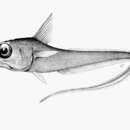fi
nimet breadcrumb-navigoinnissa


La cua de rata (Hymenocephalus italicus) és una espècie de peix de la família dels macrúrids i de l'ordre dels gadiformes.
Menja principalment copèpodes pelàgics i, també i en ordre decreixent, eufausiacis, amfípodes, gambes, ostràcodes, Cumacea i peixets.[7]
Als Estats Units és depredat per Merluccius albidus.[8][9]
És un peix bentopelàgic i marí d'aigües subtropicals que viu entre 100-1400 m de fondària.[5][10][11]
Es troba des de Portugal[12] fins a Angola[13] (incloent-hi la Mar Mediterrània)[14][15][16][17][18][19][20][21][22][23][24][25][26][27] i des de l'Estret de Florida fins al nord del Brasil (incloent-hi el Golf de Mèxic i el Carib).[28] També és present al Golf d'Aden, Zanzíbar i les Maldives.[29][5][30][31][32][33][34][35][36]
Pot arribar a viure 9 anys.[37]
La cua de rata (Hymenocephalus italicus) és una espècie de peix de la família dels macrúrids i de l'ordre dels gadiformes.
The glasshead grenadier (Hymenocephalus italicus) is a species of fish in the family Macrouridae.[3][4][5][6]
The glasshead grenadier has a measurement of up to 25 cm (9.8 in). Its snout is obtuse and projects slightly beyond the mouth. Its barbel is small, and its scales are thin, deciduous, spiny and large.[7]
The glasshead grenadier lives in the Atlantic Ocean;[8] it is benthopelagic, living at depths of 100–1,400 m (330–4,590 ft).[9]
The glasshead grenadier feeds on pelagic copepods, euphausiids and gammarid amphipods, shrimp, ostracods, cumaceans and other small crustaceans.[9][10]
The glasshead grenadier (Hymenocephalus italicus) is a species of fish in the family Macrouridae.
Hymenocephalus italicus es una especie de pez de la familia Macrouridae en el orden de los Gadiformes.
• Los machos pueden llegar alcanzar los 25 cm de longitud total.[1][2]
Come principalmente copépodos pelágicos y, también y en orden decreciente, cochinillas de la humedad, anfípodos, gambas, ostràcodes,Cumacea y pecesitos.
En los Estados Unidos es depredado por Merluccius albidus
Es un pez bentopelágico y maríno de aguas subtropicales que vive entre 100-1400 m de profundidad.
Se encuentra desde Portugal hasta Angola (incluyendo la Mar Mediterráneo) y desde el Estrecho de Florida hasta el norte de Brasil (incluyendo el Golfo de México y el Caribe). También está presente en el Golfo de Adén, Zanzíbar y las Maldivas.
Hymenocephalus italicus es una especie de pez de la familia Macrouridae en el orden de los Gadiformes.
Hymenocephalus italicus Hymenocephalus generoko animalia da. Arrainen barruko Macrouridae familian sailkatzen da.
Espezie hau honako ekosistematan aurki daiteke:
Hymenocephalus italicus Hymenocephalus generoko animalia da. Arrainen barruko Macrouridae familian sailkatzen da.
Il pesce topino (Hymenocephalus italicus) è un pesce abissale della famiglia Macrouridae.
Comune nel mar Mediterraneo e nelle acque italiane ma raro nel mar Adriatico; è anche presente nell'Oceano Atlantico tra il Portogallo e l'Africa meridionale. Si hanno segnalazioni per il mar dei Caraibi, il golfo del Messico e l'Oceano Indiano.
Frequenta acque profonde da 200 a 2000 metri.
Rispetto agli altri Macrouridae ha un rostro molto ridotto e quindi non ha il muso prominente tipico del pizzuto o del pesce sorcio. La sua testa è coperta di creste ossee disposte in maniera irregolare che delimitano aree mucose. La bocca è orizzontale e molto ampia e supera l'occhio, che è grande. Il corpo è molto sottile e termina in una coda lunga e fine; non c'è la pinna caudale. La prima pinna dorsale è alta e breve, la seconda molto bassa, arriva all'estremità del corpo. La pinna anale è simile alla seconda dorsale ma più lunga. Sono presenti due fotofori, uno accanto all'ano ed uno tra le pinne ventrali.
Il colore è argenteo su dorso e fianchi e nero sul ventre.
Misura fino a 20 cm.
Si nutre di animaletti bentonici, soprattutto crostacei.
Le uova e le larve sono pelagiche e queste ultime hanno pinne pettorali e pinne ventrali con raggi allungati.
Spiaggia sulle coste dello stretto di Messina nei mesi primaverili.
Sembra avere abitudini meno legate al fondo delle altre specie di pesci topo tanto da potersi considerare come semi-pelagico.
Si cattura con le reti a strascico ed è commestibile ma privo di qualsiasi valore alimentare.
Il pesce topino (Hymenocephalus italicus) è un pesce abissale della famiglia Macrouridae.
Hymenocephalus italicus is een straalvinnige vissensoort uit de familie van de rattenstaarten (Macrouridae).[1] De wetenschappelijke naam van de soort is voor het eerst geldig gepubliceerd in 1884 door Giglioli.
Bronnen, noten en/of referenties大西洋膜首鱈,為輻鰭魚綱鱈形目鼠尾鱈科的其中一種,分布於東大西洋葡萄牙至安哥拉,包括地中海;西大西洋佛羅里達海峽至墨西哥;印度洋亞丁灣、馬爾地夫海域,屬深海底棲性魚類,深度100-1400公尺,體長可達25公分,棲息在底中層水域,以橈腳類等為食,生活習性不明。
大西洋膜首鱈,為輻鰭魚綱鱈形目鼠尾鱈科的其中一種,分布於東大西洋葡萄牙至安哥拉,包括地中海;西大西洋佛羅里達海峽至墨西哥;印度洋亞丁灣、馬爾地夫海域,屬深海底棲性魚類,深度100-1400公尺,體長可達25公分,棲息在底中層水域,以橈腳類等為食,生活習性不明。